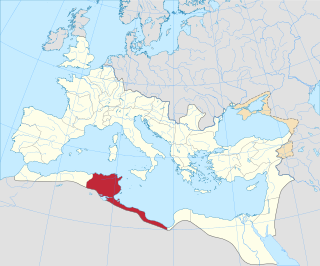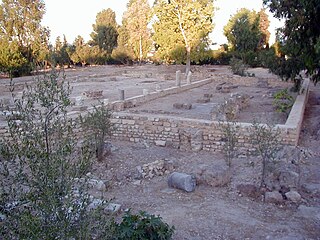
Marazanae was a Roman town of the Roman province of Byzacena [1] [2] during the Roman Empire and into late antiquity. [3] [4]

Marazanae was a Roman town of the Roman province of Byzacena [1] [2] during the Roman Empire and into late antiquity. [3] [4]
The town was between Sufes and Aquae Regiae. [5] [6]
The ruins at Henchir-Guennara, [7] (Tunisia) dating from the Roman Empire are tentatively attributed to Marazanae. [8] The town appears on the Antonine Itinerary [9] and is believed to have been on a crossroads during antiquity.
The town was also the seat of an ancient Christian bishopric. [10] During the Donatist controversy there were congregations both of Catholics and of Donatists in the town. [11] Marazane, perhaps identifiable with Henchir-Guenmara in today's Tunisia, is an ancient episcopal seat of the Bizacena Roman province.
There are five ancient documented bishops of Marazane. [12] [13]
Today the bishopric of Marazane survives as a titular bishopric [14] and the current bishop is Krzysztof Chudzio, auxiliary bishop of Przemyśl.

Thelepte was a city in the Roman province of Byzacena, now in western Tunisia. It is located near the border with Algeria about 5 km north from the modern town of Fériana and 30 km south-west of the provincial capital Kasserine.

Assuras, sometimes given as Assura or Assur, was a town in the Roman province of Proconsular Africa.

Abitinae was a town in the Roman province of Africa Proconsularis and is famed for the Martyrs of Abitinae.

Girus Tarasii was a town in the Roman province of Numidia that became a residential episcopal see. It is tentatively identified with ruins situated at what is now called Henchir-Tarsa in Algeria.
Azura was an ancient civitas and bishopric in Roman North Africa– It remains only as Latin Catholic titular see.

The Archdiocese of Carthage, also known as the Church of Carthage, was a Latin Catholic diocese established in Carthage, Roman Empire, in the 2nd century. Agrippin was the first named bishop, around 230 A.D. The temporal importance of the city of Carthage in the Roman Empire had previously been restored by Julius Caesar and Augustus. When Christianity became firmly established around the Roman province of Africa Proconsulare, Carthage became its natural ecclesiastical seat. Carthage subsequently exercised informal primacy as an archdiocese, being the most important center of Christianity in the whole of Roman Africa, corresponding to most of today's Mediterranean coast and inland of Northern Africa. As such, it enjoyed honorary title of patriarch as well as primate of Africa: Pope Leo I confirmed the primacy of the bishop of Carthage in 446: "Indeed, after the Roman Bishop, the leading Bishop and metropolitan for all Africa is the Bishop of Carthage."

Simminensis is an ancient and titular episcopal see of the Roman province of Africa Proconsularis in modern Tunisia, and a suffragan diocese of the Archdiocese of Carthage.

Unizibira was an ancient town and bishopric in Roman North Africa which remains a Latin Catholic titular see.
Rotaria was an ancient Roman and Byzantine era bishopric of Numidia, North Africa.

Aptuca (Africa) or Henchir Oudeka, also known as Aptucca/Aptuca, Henchir-Oudeka/Henchir-Semmech. or Udeka is a village and archaeological site in Tunisia, North Africa located at 36.409344, 8.940301.

Lamzella was a civitas (town) in the Roman–Berber province of Numidia. It has been tentatively identified with the ruins at Henchir-Resdis in modern Algeria.

Semta was a Roman era Municipium also known as Augustum Semta in Africa Proconsularis that is tentatively identified with ruins at Henchir Zemba (Dzemda) Carthage, Tunisia near the Oued el Kebir 20 km (12 mi) southwest of Zaghouan at 36.269282, 9.887345.

Auzegera was a Roman-Berber town in the province of Africa Proconsularis and in late antiquity Byzacena. It was a Catholic Church diocese.
Drusiliana was a civitas (town) of Roman North Africa. Bingham called it a city of the Roman province of Mauretania Caesariensis. An inscription of Constantine the Great was found in the city ruins and it appears on the Tabula Peutingeriana The town has been tentatively identified with ruins near Khanguet-el-Kdim in northern Algeria. . Located at 36.249547N, 8.907667E. Epigraphical evidence suggest Constantine the Great undertook some works in the city in 312AD.
Henchir-El-Meden is a locality and archaeological site in Tunisia.
Henchir-Baldia is an archaeological site and locality in southern Tunisia. The stone ruins are tentatively associated with Bladia, a civitas of the Roman province of Byzacena during the Roman Empire. It was a Catholic bishopric.
Baia was an ancient city and bishopric in the Roman province of Africa Proconsulare. It is a Roman Catholic titular see.

Iomnium was a Phoenician, Carthaginian, and Roman port on Algeria's Mediterranean coast at the site of present-day Tigzirt.

Tubusuctu also known as Colonia Iulia Augusta Legionis VII, was a Roman colony founded by Augustus for military veterans and known for its olive oil.

The diocese of Tanudaia is a suppressed and titular see of the Roman Catholic Church located in today's Tunisia.